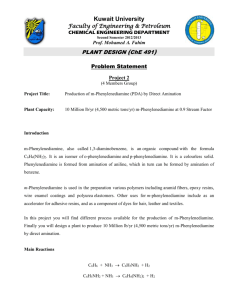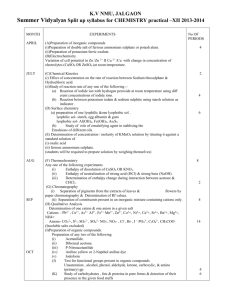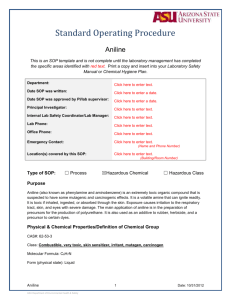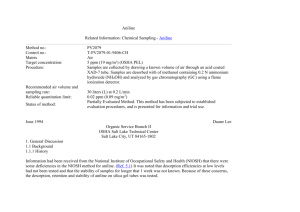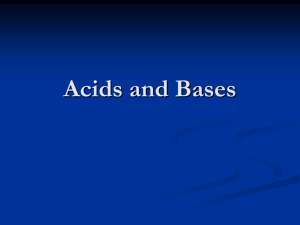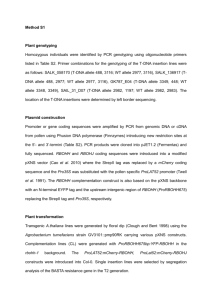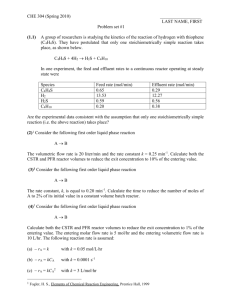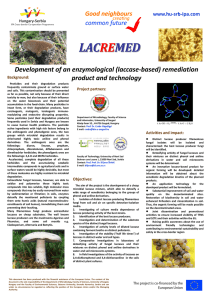Production of Aniline
advertisement
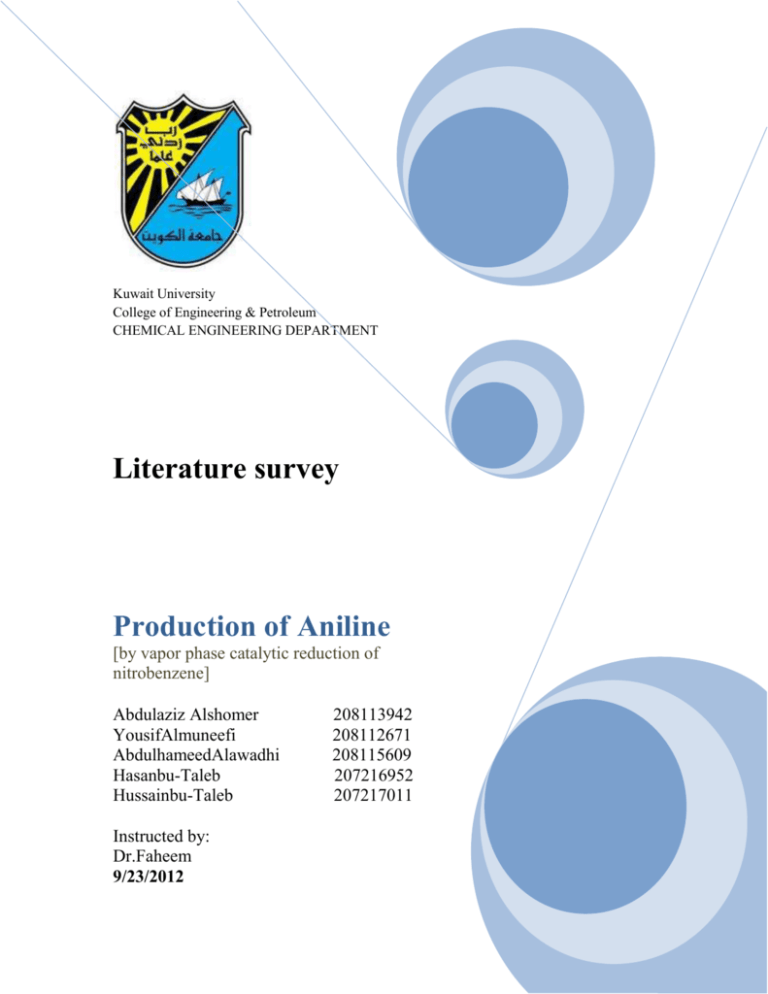
Kuwait University College of Engineering & Petroleum CHEMICAL ENGINEERING DEPARTMENT Literature survey Production of Aniline [by vapor phase catalytic reduction of nitrobenzene] Abdulaziz Alshomer YousifAlmuneefi AbdulhameedAlawadhi Hasanbu-Taleb Hussainbu-Taleb Instructed by: Dr.Faheem 9/23/2012 208113942 208112671 208115609 207216952 207217011 Table of Content: # 1 2 3 4 5 6 7 8 9 10 11 12 13 Topic List of Tables List of Figures Introduction History World Production and Consumption Uses Feedstock and product Description Process Flow Sheet Comparison flow sheets Basic economic analysis Conclusion Recommended flow sheet References 2 Pages 3 5 5 6 7-9 9 10-20 21-29 30 31 32 32 33 List of Tables: Table (1-1)Aniline Global supply and demand……………7 Table 1-2 Aniline supply and demand in U.S………………. 7 Table (1-3)Aniline supply and demand in china…………….8 Table (1-4)Aniline’s china consumption capacity…………. 9 Table (1-5)Aniline Uses…………………………………………9 Table (1-6)Physical and chemical properties of Benzen…..10 Table (1-7)Physical and chemical properties of Nitrobenze 11 Table (1-8)Physical and chemical properties of ammonia... 12 Table (1-9)Physical and chemical properties of phenol….... 12 Table (1-10)Physical and chemical properties of Hydrogen. 13 Table (1-11)Physical and chemical properties of water……. 14 Table (1-12)Physical and chemical properties of Nitric Acid. 15 Table (1-13)Physical and chemical properties of sulfuric acid…… 16 Table (1-14)Physical and chemical properties of iron………………. 17 Table (1-15)Physical and chemical properties of Hydrochloric Acid. 18 Table (1-16)Physical and chemical properties of ferric chloride........ 19 Table (1-17)Physical properties of aniline…………………………...... 20 Table (1-18)Name and description unit………………………….......... 26 Table (1-19)Feedstock condition …………………………………….... 26 Table (1-20)Product condition……………………….……………..….. 26 Table (1-21)Name of stream……………………………………...27 3 Table (1-22)Alternative #1……….……………………………………..30 Table (1-23)Alternative #3………………………….…………………..30 Table (1-24) Comparison between the alternatives ……………………..30 Table (1-25)Cost of materials…………………………………………. 31 List of Figures: Figure (1-1)Structure of Aniline…………………………………………….5 Figure (1-2)World consumption of Aniline-2010……...…………8 Figure (1-3)Process flow sheet of the production of aniline by Ammonolysis of Phenol…………………………………………21 Figure (1-4)Process flow sheet of the production of aniline by liquid phase reduction of nitrobenzene……………………………..………...23 Figure (1-5)Process flow sheet of the production of aniline by vapor phase reduction of nitro benzene……………………………………….25 4 Introduction: Aniline, phenylamine or aminobenzene is a colorless organic compound (aromatic amine) which has the formula C6H5NH2. It contains two groups (phenyl group and amino group) linked together. Aniline is toxic by inhalation of the vapor and by skin absorption.It is flammable liquid that is slightly soluble in water and soluble in alcohol and ether. Aniline is a primary amine in which one of hydrogen atoms in the ammonia molecule is exchanged by the phenyl group. The simplest way to write the structure of aniline is: Figure(1-1) Structure of Aniline It is a main material that is used in chemical industries; also it has a fish rotten like smell. 5 History: Aniline was first isolated from the destructive distillation of indigo in 1826 by crystalline. In 1834, Friedrich Rungeisolated a substance from coal tar which produced a beautiful blue color on treatment with chloride of lime, which he named kyanol or cyanol. In 1841, C. J. Fritzsche showed that by treating indigo with caustic potash it producesoil, which he named aniline. About the same time N. N. Zinin found that on reducing nitrobenzene, a base was formed which he named benzidam. August Wilhelm von Hofmann investigated these variously prepared substances, and proved them to be identical (1855), and since then they took their place as one body, under the name aniline or phenylamine. The first industrial-scale use was in the manufacture of mauveine, a purple dye discovered in 1856 by William Henry Perkin. One of aniline derivatives called (p-Toluidine), can be used in qualitative analysis to prepare carboxylic acid derivatives. Developments in medicine In the late 19th century, aniline emerged as an analgesic drug, its cardiacsuppressive side effects countered with caffeine. 6 World production& Consumption of Aniline: * World production: MDI [methylene diphenyldisocyanate] has been the driving force behind the recovery of the aniline business since 1982 when the industry had acapacity utilization rate of less than 50%. By 1996‚ capacity utilization hadapproached 95% in some regions. Thecapacity ofworld production ofanilinein 1999 was found in these regions: Western Europe - 47%‚ North America -30% and Asia / Pacific 19%. million ton/year 1.5 2.2 2.9 2.97 4 Year 1988 1996 1996 2000 2010 Table (1-1) Aniline Global supply and demand1 Historicalproduction in the United States is summarized in Table 1-1. Millions of Pounds Type Capacity Total prod. Imports Exports Demand 1995 1380 1996 1420 1997 1535 1998 1745 1999 1745 2000 2310 2001 2310 1388 67 1321 1395 24 41 1378 1339 60 19 1380 1545 42 43 1544 1588 26 38 1574 1866 11 58 1819 1975 12 65 1922 Table (1-2) Aniline supply and demand in U.S2 7 Year 1996 2000 2004 2005 ton/year 142,700 200,000 435,000 620,000 Table (1-3) Aniline supply and demand in china3 World consumption of Aniline: western europe china united states japan Rep.of korea Central/Eastern Europe India Central/South africa other Figure (1-2) World consumption of Aniline-2010 World consumption of aniline grew at an average annual rate of 3% during 2006–2010, the result of a growing global economy during 2001–2008, declines during the economic recession in 2009 and the recovery in 2010, and growth due to increased MDI capacity. Strong Asian demand for all applications of MDI boosted world demand during 2006–2010. World consumption of aniline is forecast to grow at an average annual rate of 3.8% during 2010–2015. Continuing rapid demand growth in some regions, particularly in China, Other Asia and Europe, mainly the result of continued expansion of 8 nitrobenzene/aniline/MDI units, will balance out moderate growth in markets such as the Americas. Chinas consumption structure of aniline is different from developed countries, primarily used in rubber processing additives, dyes and organic pigments, pharmaceuticals and organic intermediates production. Year 1993 1999 2000 2004 2010 consumption(kt) 100 148.4 177.9 387 1100 Table (1-4)Aniline’s china consumption capacity4 Uses Aniline is mainly used as feed stock for the polyurethane industry. The largest application of aniline is for the preparation of methylene diphenyldisocyanate(MDI).Other uses include rubber processing chemicals (9%), herbicides (2%), and dyes and pigments (2%).Many drugs can be prepared from aniline such as paracetamol(acetaminophen)and used in the dye industry as a precursor to indigo. Application Isocyanate Rubber Chemicals Agricultural Chemicals – Pesticides Dyes & Pigments Specialty Fibers Miscellaneous Table (1-5)Aniline Uses5 9 % 85% 9% 3% 2% 1% 1% Feed stock & product description: Benzene: Molecular formula C6H6 Molar mass 78.11 g mol−1 Appearance Colorless liquid Density 0.8765(20) g/cm3 Melting point 5.5 °C, 278.7 K Boiling point 80.1 °C, 353.3 K Solubility in water 1.8 g/L (15 °C) Lambda(λ)max 255 nm Viscosity 0.652 cP at 20 °C Dipole moment 0D Table (1-6)Physical and chemical properties of Benzene6 Nitrobenzene: Molecular formula Molar mass C6H5NO2 123.06 g/mol Appearance Density Melting point Boiling point Solubility in water yellowish liquid 1.199 g/cm3 5.7 °C 210.9 °C 0.19 g/100 ml at 20 °C Table(1-7) Physical and chemical properties of Nitrobenzen7 10 Ammonia: Molecular formula NH3 Molar mass 17.031 g/mol Appearance Colourless gas with strong pungent odour Density 0.86 kg/m3 (1.013 bar at boiling point) 0.73 kg/m3 (1.013 bar at 15 °C) 681.9 kg/m3 at −33.3 °C (liquid) 817 kg/m3 at −80 °C (transparent solid) Melting point −77.73 °C, 195 K, -108 °F Boiling point −33.34 °C, 240 K, -28 °F Solubility in water 47% (0 °C) 31% (25 °C) 28% (50 °C) Acidity (pKa) 32.5 (−33 °C), 10.5 (DMSO) Basicity (pKb) 4.75 Structure Molecular shape Trigonal pyramid Dipole moment 1.42 D Thermochemistry 11 Std enthalpy of formation ΔfHo298 −46 kJ·mol−1 Standard molar entropySo298 193 J·mol−1·K−1 Table(1-8) Physical and chemical properties of ammonia8 Phenol: Molecular formula C6H6O Molar mass 94.11 g mol−1 Appearance transparent crystalline solid Density 1.07 g/cm3 Melting point 40.5 °C, 314 K, 105 °F Boiling point 181.7 °C, 455 K, 359 °F Solubility in water 8.3 g/100 mL (20 °C) Acidity (pKa) 9.95 (in water) 29.1 (in acetonitrile) Dipole moment 1.7 D Table (1-9)Physical and chemical properties of phenol9 12 Hydrogen: Molecular H2 Phase gas Density (0 °C, 101.325 kPa) 0.08988 g/L Liquid density at (m.p) 0.07 (0.0763 solid) g·cm−3 Liquid density at (b.p) 0.07099 g·cm−3 Melting point 14.01 K, -259.14 °C, -434.45 °F Boiling point 20.28 K, -252.87 °C, -423.17 °F Triple point 13.8033 K (-259°C), 7.042 kPa Critical point 32.97 K, 1.293 MPa Heat of fusion (H2) 0.117 kJ·mol−1 Heat of vaporization (H2) 0.904 kJ·mol−1 Table (1-10) Physical and chemical properties of Hydrogen10 13 Water: Molecular formula H2O Molar mass 18.01528(33) g/mol Appearance white solid or almost colorless, transparent, with a slight hint of blue, crystalline solid or liquid Density 1000 kg/m3, liquid (4 °C) (62.4 lb/cu. ft) 917 kg/m3, solid Melting point 0 °C, 32 °F, (273.15 K) Boiling point 99.98 °C, 211.97 °F (373.13 K) Acidity (pKa) 15.74 ~35–36 Basicity (pKb) 15.74 Refractive index (nD) 1.3330 Viscosity 0.001 Pa s at 20 °C Table (1-11) Physical and chemical properties of water11 14 Nitric Acid: Molecular formula HNO3 Molar mass 63.01 g mol−1 Appearance Colorless liquid Density 1.5129 g cm−3 Melting point -42 °C, 231 K, -44 °F Boiling point 83 °C, 356 K, 181 °F (68% solution boils at 121 °C) Solubility in water Completely miscible Acidity (pKa) -1.4 Refractive index 1.397 (16.5 °C) (nD) Dipole moment 2.17 ± 0.02 D Thermo chemistry Std enthalpy of formation ΔfHo298 −207 kJ·mol−1 Standard molar entropySo298 146 J·mol−1·K−1 Table(1-12) Physical and chemical properties of Nitric Acid12 15 Sulfuric Acid: Molecular formula H2SO4 Molar mass 98.079 g/mol Appearance Clear, colorless, odorless liquid Density 1.84 g/cm3, liquid Melting point 10 °C, 283 K, 50 °F Boiling point 337 °C, 610 K, 639 °F Solubility in water Miscible Acidity (pKa) −3, 1.99 Viscosity 26.7 cP (20 °C) Thermo chemistry Std enthalpy of formation ΔfHo298 −814 kJ·mol−1 Standard molar entropySo298 157 J·mol−1·K−1 Table (1-13) Physical and chemical properties of sulfuric acid13 16 Iron: Molecular formula Fe Density 7.874 g·cm−3 Liquid density at m.p. 6.98 g·cm−3 Melting point 1811 K, 1538 °C, 2800 °F Boiling point 3134 K, 2862 °C, 5182 °F Heat of fusion 13.81 kJ·mol−1 Heat of vaporization 340 kJ·mol−1 Molar heat capacity 25.10 J·mol−1·K−1 Table (1-14) Physical and chemical properties of iron14 17 Hydrochloric acid: Molecular formula HCl Molar mass 36.46 g mol−1 Appearance Colorless gas Odor Pungent Density 1.490 g L−1 Melting point -114.22 °C, 159 K, -174 °F Boiling point -85.05 °C, 188 K, -121 °F Vapor pressure 4352 kPa (at 21.1 °C) Acidity (pKa) -7.0 Basicity (pKb) 21.0 Refractive index (nD) 1.0004456 (gas) Table (1-15) Physical and chemical properties of Hydrochloric Acid15 18 Ferric chloride: Molecular formula Molar mass FeCl3 162.2 g/mol (anhydrous) Appearance 270.3 g/mol (hexahydrate) green-black by reflected light; purple-red by transmitted light hexahydrate: yellow solid aq. solutions: brown Odor Density slight HCl 2.898 g/cm3 (anhydrous) Melting point 1.82 g/cm3 (hexahydrate) 306 °C (anhydrous) Boiling point 37 °C (hexahydrate) 315 °C (anhydrous, decomp) Solubility in water 280 °C (hexahydrate, decomp) (partial decomposition to FeCl2+ Cl2) 74.4 g/100 mL (0 °C) 92 g/100 mL (hexahydrate, 20 °C) Solubility in acetone 63 g/100 ml (18 °C) Methanol highly soluble Ethanol Diethyl ether 83 g/100 ml highly soluble Viscosity 40% solution: 12 cP Table (1-16) Physical and chemical properties of ferric chloride16 19 Aniline: Molecular formula C6H5NH2 Molar mass 93.13 g/mol Appearance colorless to yellow liquid Density 1.0217 g/mL, liquid -6.3 °C, 267 K, 21 °F Melting point 184.13 °C, 457 K, 363 °F Boiling point Solubility in water 3.6 g/100 mL at 20°C Acidity (pKa) 4.7 Basicity (pKb) 9.3 Thermochemistry Std enthalpy of formation ΔfHo298 -3394 kJ/mol DMSO:dimethylsulfoxide Table (1-17) Physical properties of aniline17 20 Process Flow Sheets: Process 1;Ammonolysis of Phenol 24 14 17 V-100 P-102 21 10 K-100 13 16 CRV-100 9 Amonia 1 MIX-100 phenol 20 19 8 7 2 29 E-100 E-101 27 12 T-100 18 30 E-103 V-101 34 Aniline 27 28 26 11 P-104 T-101 25 31 24 E-104 35 E-102 28 T-102 32 29 P-103 36 33 E-105 37 Figure (1-3) Process flow sheet of the production of aniline by Ammonolysis of Phenol. Process description:The process is divided into three sections: the feed preparation section, the reactor section, and the purification section. In the feed preparation section, The ammonia feed (stream 1) consists of 203 lb-mol/hr liquid ammonia at 90F. The phenol feed (stream 2) supplies 165.8 lb-mol/hr liquid phenol at 110F and atmospheric pressure. The two feed streams are pumped to increase the pressure before they are mixed with their respective recycle streams (stream 16 for ammonia and stream 31 for phenol) by using mixer 21 (MIX-102).(Stream 7) is heated in a heat exchanger (E-100) with the reactor effluent (stream 10). The heat exchanger effluent (Stream 8) is heated to the required reactor temperature for the reactor inlet (stream 9). The reactor section includes the adiabatic reactor (CRV-100) that includes a bed Packed with a silica-alumina catalyst. In the reactor, three reactions occur: Phenol + NH3 ==> Aniline + H2O 2 Phenol + NH3 ==> Diphenylamine + 2 H2O 2 NH3<==> 3 H2 + N2 The conversion of phenol in the reactor is 95% with a 99% selectivity to aniline as shown in the First reaction. The second reaction forms a byproduct (diphenylamine), while the third reaction is the decomposition of ammonia. The reaction set is exothermic, so the stream leaving the reactor (stream 10) is hotter than stream 9. The cooling of the reactor effluent begins with the heat exchanger (E-100) which will be cooled from (stream 10) to (stream 11). After that (stream 11) is sent through a cooler (E-102). The purification section consists of the distillation columns to separate the chemicals into Products and non-products. The absorption column (T-100) separates the gases and the liquids. As a result, all of the hydrogen and nitrogen go to stream13. Moreover, all of the phenol, aniline and diphenylamine go to stream 18. From the absorption column, stream 13 goes to a splitter to split it into stream 14, which is the ammonia recycle stream that will pass through a compressor (K-100) to increase the pressure. On the other hand, the splitter also sends small amount of stream 13 to the gaseous purge (stream 24). The bottoms stream (stream 18) is one of the feeds to the next column (T-101). The distillate (stream19) is cooled by the unit (E-103). Stream 20 is then sent to a separator (V-100) to separate the water and the phenol product. Then, the phenol (stream 21) is recycled to the column (T- 22 101) after pressurize it by using (P-102). The aqueous product (stream 24) from V-100 will be treated. The bottoms stream (stream 25) is the feed to the next column (T-102). The main component in the distillate (stream 26) is aniline which should be pumped by (P-104). The resulting stream (stream 27) is cooled by (E-104) to produce aniline (Stream 28). Then, (stream 29) should be pumped by (P-103) to get the suitable condition (stream31) for mixing by (MIX-102). The bottoms product (stream 32) is cooled b (E-105) to purchase diphenylamine in (stream 33). Process 2;Liquidphase reduction of nitrobenzene with metal in mineral acids. Sulfuric acid 13 3 Nitric acid 2 9 MIX-100 8 Aniline 12 Benzene 1 14 CRV-101 5 4 15 T-101 V-100 6 CRV-100 nitrobenzene 10 11 V-101 7 T-100 RCY-100 Figure (1-4) Process flow sheet of the production of aniline by liquid phase reduction of nitrobenzene. 23 Process description : First of all, nitric acid and sulfuric acid is mixed together by using an acid mixer(mix-100). the mixed acid and benzene are fed in a nitrate reactor(CRV-100) and the reaction will occur as the following chemical equation :C6H6 +HNO3(H2SO4) C6H5NO2 + H2O(H2SO4) ΔH=-113KJ Then the reactor effluent will enter the separator (V-100) which will separate it into two streams which are crude nitrobenzene and the reactor effluent acid that will be recovered to the reactor feed. The crude nitrobenzene could be washed by using a dilute alkali (V-101) such as water and sodium carbonate and distillated by still distillation column (T-100) to produce a pure nitrobenzene. The crude nitrobenzene will enter a reducer [H2] reactor (CRV-101) with an iron boring catalyst and hydrochloric acid to produce aniline and water which will occur as the following chemical equation:4C6H5NO2 + 9Fe + 4H2O 4C6H5NH2 + 3FeO4 And the effluent nitrobenzene will be recovered to the reducer reactor. The aqueous aniline could be heated by steam to get crude aniline which can be distilled by using still distillation column (T-101) to produce pure aniline. Catalyst Reaction : HCl Yeild : 98% 24 Process 3;Process catalytic reduction of nitrobenzene in a fluidized bed reactor. 8 5 E-102 3 E-101 Water 10 Hydrogen 4 6 V-100 Nitrobenzene 9 7 T-100 4 2CRV-100 1 12 P T-101 11 Aniline K-100 E-100 Figure (1-5) Process flow sheet of the production of aniline by vapor phase reduction of nitro benzene. 25 Name of Unit Description E-100 CRV-100 E-101 K-100 V-100 T-100 E-102 T-101 Nitrobenzene vaporizer Reactor Product Condenser Hydrogen Recycle Compressor Aniline water decanter Crude aniline distillation Condenser Aniline product distillation Table (1-18) Name and description unit Species Flowrate ( million lb/yr) Nitrobenzene - Compostion Temperature Pressure (C°) (atm) 0.1 25 1 Hydrogen 0.9 - 25 1 Table (1-19) Feedstock condition Species Aniline Water Flowrate (million lb/yr) 200 - Compostion Temperature Pressure (C°) (bar) 0.995 - - Table(1-20) Product condition 26 1 1 Name of stream S1 S2 S3 S4 S5 S6 S7 S8 S9 S10 S11 S12 Description Nitrobenzene Hydrogen Feed Reactor Product Gases Condensed Materials Non-Condensable gas Crude Aniline Aqueous Phase Overheads Bottom Streams Water Aniline product Recycled bottom Table (1-21) Name of stream Process description: The main process for aniline production is the nitrobenzene hydrogenation reactions. Feed preparation section: The liquid nitrobenzene feed (contains less than 10ppm – thiophene) (S1) is vaporized up by going into vaporizer (E-100) to reach the required temperature for the fluidized bed reactor after the mixing point between the nitrobenzene feed (S1) and the hydrogen feed (S2) (which has been compressed by Recycle Compressor) (K-100).Hydrogen to nitrobenzene ratio is 9:1. 27 Reaction section: It includes the fluidized bed reactor (CRV-100) with 10-20% copper by weight on silica catalyst [which is made by spray-drying a silicic acid matrix (20 to 150 micrometer) with a cuprammonium compound and activated in position with hydrogen at 250 C] at 270 C and 1.5 atm, the equation for this process is shown below: C6H5NO2 + 3H2 --------> C6H5NH2 + 2H2O The reaction is highly exothermic with enthalpy (-443 KJ/mol) and approximately 65% of the heat of reaction is removed by circulating a cool fluid (generally water or low pressure steam) through tubes suspended in the fluidized bed. The nitrobenzene vapor-hydrogen mixture (300 percent excess hydrogen) reaction takes place on the surface porous at the bottom of the fluidized bed reactor. The upper part of the reactor is large enough to allow the most of the catalyst to fall back into the main catalyst bed. any catalyst which escapes from the reactor is removed from the product by stainless steel filters.The conversion of the nitrobenzene in the reactor is 99.7% and the selectivity to aniline is 99%. 28 Purification section: The reactor (RCV-100) product gas mixture (aniline , hydrogen and water) (S3) will enter the condenser (E-101)and the leaving gas stream (3.5% water, 0.5% aniline and the balance hydrogen) (S5) which has been recycled to the compressor (K-100), but a small part is vented to avoid the buildup of gaseous impurities which exist in hydrogen feed. Moreover the aqueous and organic phases stream (S4) is separated in a decanter (V-100) which separates the crude aniline (S6) from the aqueous phase solution (S7). The organic phase (crude aniline) is consist of aniline up to 0.5% nitrobenzene, and 5% water is purified by two stage distillation column. After that in the crude still column (T-100) (stripping) ,aniline and water are removed overhead while higher boiling organic impurities, such as nitro-benzene remain in the still bottoms. The overhead product (S9) from the first column is purified in a finishing still (T-101), Water (S10) is withdrawn from the top of the column while aniline (S11) is withdrawn in a side stream near the bottom of the column. The bottom (S12) is recycled to the crude still (T100). Waste treatment: The best method of treating the aqueous waste resulting from the following units (nitrobenzene distillation column overhead(stream8), nitrobenzene wash water(stream7) and the aniline recovery column purge(stream12)), is the biological treatment due to its inexpensive cost and it's high efficiency indicator which could of the toxic nature of the waste which may affect the environment , moreover the physical method that used as stream stripping and liquid-liquid extraction. Catalyst Regeneration. the catalyst can be regenerated with air periodically.At 250-350°C and subsequent H2 treatment. 29 Comparison flow sheets: Alternative 1 Mole M.wt Ib ton Ib/Ib of aniline $/Ib Gross Profit = phenol 1 94 94 0.047 1.01 0.745 -0.428 ammonia 1 17 17 0.0085 0.182 0.289 aniline 1 93 93 0.0465 1 0.38 Water 1 18 18 0.009 0.193 - Table(1-22) Alternative #1 Alternative 2: -There is no enough information to calculate the gross profit for the process. Alternative 3 Mole M.wt Ib Ib/Ib of aniline $/Ib Gross Profit = nitrobenzene 1 123 123 1.322 0.33 0.076 hydrogen 3 2 6 0.064 0..32 aniline 1 93 93 1 0.38 Water 2 18 36 0.387 - Table (1-23) Alternative #3 Alternative 1 No.of equipment 17 2 3 9 8 Catalyst Raw Material Silicaalumina Iron borings Copper on silica Phenol + Ammonia Benzene + Nitric acid Nitrobenzene + Hydrogen Table(1-24) Comparison between the alternatives 30 Basic economic analysis: Ammonia Description Weight US Gulf, spot c.f.r. Tampa tonne Ammonia Aniline US Gulf, spot f.o.b New Orleans tanks, f.o.b technical grade, 100% basis, tanks, Ferric chloride f.o.b. works Hydrochloric 22 deg. Be, US Gulf dom. ex-works acid US NE Hydrochloric 22 deg. Be, US Gulf dom. ex-works acid USG Nitrobenzene tanks, f.o.b. Sulphuric acid virgin 100%, tanks, works, East Coast ton lb Sulphuric acid Sulphuric acid Sulphuric acid Sulphuric acid Sulphuric acid ton ton ton ton ton virgin 100%, tanks, works, Southwest virgin 100%, tanks, works, Midwest virgin 100%, tanks, works, Southeast virgin 100%, tanks, works, West Coast smelter 100% tanks, works, Gulf Coast lb tonne 85.43 tonne lb ton 93.7 0.33-0.34 1450 57.0085.00 87 94 73.1 94 50.0062.00 25.0030.00 67 215.00225.00 1472.311507.69 1015.381192.31 0.32 Sulphuric acid smelter 100%, tanks, works ton Sulphuric acid smelter, tanks, intro. Southeast Sulphuric acid smelter, 93% tanks, dlvd., Northwest 40 deg. Be, 42 deg. Be. tanks, c.l., Nitric acid works, 100% basis ton ton Phenol - ton Benzene Hydrogen gas - ton Ib Table (1-25) Cost of materials 31 Prices, US$ 460.00745.00 385.81771.62 0.37-0.39 300.00351.00 ton Conclusion: We figure out that there are lots of processes to produce aniline. The production of aniline is takes an active part in America and china. Locally aniline production is not exist. At the beginning, aniline was an intermediate substance for (MDS) production, according to this reason it was produced. Recommendation: The process 3 (vapor phase catalytic reduction of nitrobenzene ) is the best alternative for the production of Aniline due to its inexpensive raw materials and its highly profit comparing it to the other two alternatives.NitroBenzene is the classical feedstock for Aniline manufacture. Recently less chlorobenzene and Phenol are being used in aniline manufacturing processes in several countries. 32 References: Web sites; http://www.springerlink.com http://www.mpri.lsu.edu http://www.xakaili.com http://www.thefreedictionary.com http://www.chemicalbook.com http://price.alibaba.com http://www.icis.com http://en.wikipedia.org Books; McGraw-Hill, Shreve’s Chemical Industries, George T.Austin,1984 33
